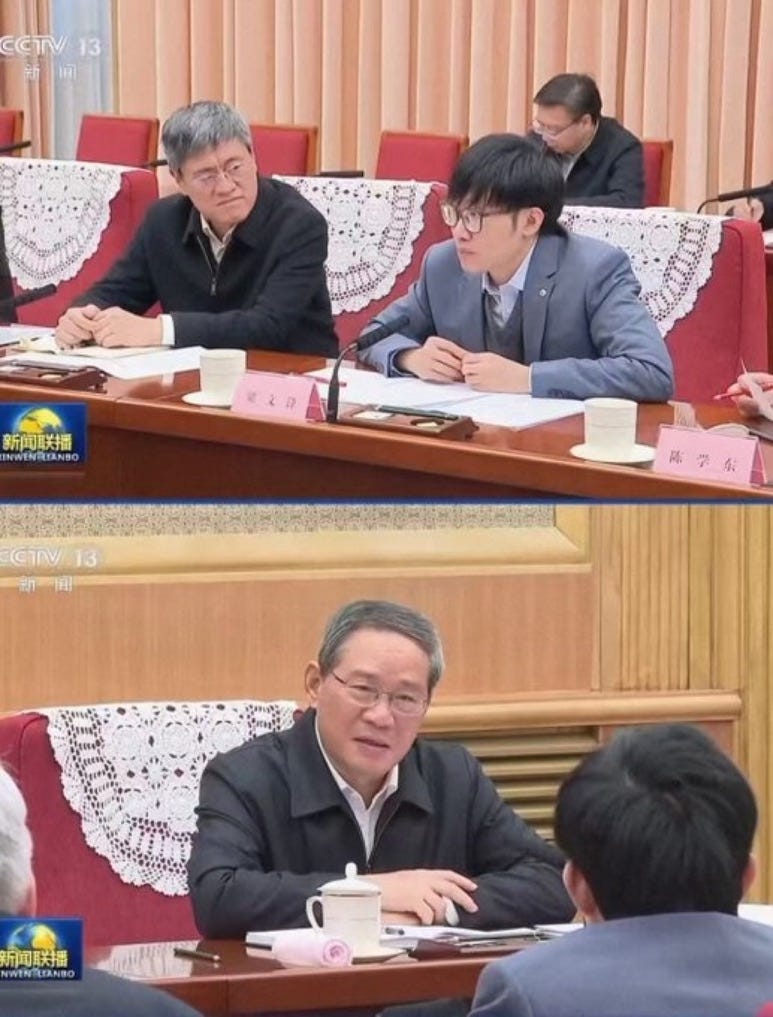Trump 2.0, Memecoins, Techno-Oligarchs and Digital Westphalia
Crypto Kleptocracy and the barbarism of an empire in decline
Three days can be a long time in global politics.
Over the course of January 19 to 21, 2025 a number of events took place that together captured the mood of the times, and perhaps tells us something about the future possibilities of the world at large.
On January 20, on a bitterly cold day in Washington DC, Donald J. Trump was sworn in - for the second time - as President of the United States. The day before, he whooped it up with the adoring MAGA flock at the Capital One Arena. Meanwhile, the TRUMP memecoin was launched followed a while later by the MELANIA meme coin. By the time the sun set on the evening of January 21, a nerdy-looking Chinese maths engineer had met with China’s Premier Li Qiang to discuss the release of DeepSeek R1. Intermingled through this flurry of events was the fallout from the US Supreme Court decision on January 19 to refuse ByteDance’s appeal against the US Congress’ laws that would see the closure of the TikTok app in the United States. Amongst all of this, China's President Xi Jinping and his Russian counterpart Vladimir Putin met via video.
This set of events speaks to an unfolding ‘story of two worlds’.
On the one hand, we have a techno-rentier political economy in which a technocratic oligarchy garners favour with the executive branch of government and where the executive arm itself exploits its status to monetise a brand. Additionally, the executive arm seeks to exercise political leverage to secure commercial outcomes in favour of the domestic oligarchs in the name of reciprocity.
On the other hand, we have a move that is akin to a scalpel-like incision into the soft underbelly of the financialised American technology model, exposing the nature of rentier capitalism and pointing to alternatives. If the former is, in the words of Rosa Luxemburg channeled via Yanis Varafoukis today’s ‘barbarism’, then the latter is the more civilised alternative. I’ve called this alternative Digital Westphalia.
Scene 1: The Pump and Dump
As the adoring flock cheered Trump’s every gesture at the Capital One Arena, an eponymous cryptocurrency was launched. As word spread, enthusiastic speculators piled in, driving the $TRUMP’s US dollar valuation up and up. This is the nature of memecoins in their social media-fuelled speculative ‘pump’ phase. Inevitably, a ‘pump’ is followed by a ‘dump’ as large and small $TRUMP holders began selling the meme token, taking monetised profit along the way. A cursory review of the blockchain scan shows that 14 wallets sold the tokens and pocketed US$56.7 million in total [1]. There are many others. These wallets never bought the token, which suggests that they belong to insiders who were gifted the token as a ‘free rider’.
By definition, meme tokens with no use value are mechanisms for the transfer of monetary balances. They are a zero sum game. The office of the presidency has been fully co-opted by the casino of financialisation with American characteristics.
The meme token has a secretion schedule that will see the complete supply of tokens released over the next 36 months; a year short of the end of the presidential term. Of the total pool, only 20% will be made available to the public, the rest are actually retained as gifts that can be monetised through the regular operations of a speculative meme token market. There may be laws against ‘pumping and dumping’ but with a near-guarantee of a presidential pardon down the track, none of this is likely to matter.
The pattern is unlikely to vary from the worn path of previous cryptocurrency pump and dump schemes. The secretion of information about impending announcements from the White House will catalyse a social media flurry - on X of course - which will then lead to a market scamper to buy the tokens, pushing the price up. The secretion of this information will, unsurprisingly, be preceded by insiders buying up while the price is low. Rinse and repeat.
Don’t be surprised if Tesla or SpaceX announces some deal to enable the redemption of $TRUMP for some feature or service upgrade. Musk has form, having accepted DOGE tokens for Tesla and SpaceX purchases.
Scene 2: The Shake Down
If that’s the casino at work, the attempt to exercise political leverage for equity in TikTok is more akin to a shake down. With the Supreme Court’s decision to reject ByteDance’s appeal, TikTok went dark on January 19, 2025 - the day before Trump’s inauguration. Trump then exercised executive prerogative and issued a 75 day stay of execution declaring that he wanted to negotiate a deal that would be based on a 50:50 joint venture format between China and the United States. Trump argued that without US licensing, TikTok would be worthless. There are some interesting ironies in all of this, not to mention a few tall tales.
The irony is that it was Trump who first turned TikTok into a political football in early 2020 when he requested it be banned. This was in the run-in to the November 2020 election, and in a febrile, racialised electoral environment, turning on TikTok was low hanging political fruit. As time went by, the Congress became further enamoured with the idea of tackling China and eventually passed legislation in 2024 that required TikTok be divested of its Chinese shareholdings or be banned. The reasoning was ostensibly data security threats. The deadline was January 19, 2025.
The second irony is that with Trump’s executive stay, the issue of data security has now fallen by the wayside. Perhaps this is temporary, and in all probability, will be re-invoked by Congressional hardliners who are deeply committed to ‘de-coupling’ from China. In any case, the equity dilution idea was aired. The claim that it’s either accepted or the company is rendered worthless.
So, how important is the US market for TikTok’s parent, ByteDance?
In fact, ByteDance gains the vast majority of its revenues from China itself, about 77-79%. The remainder is from the rest of the world, of which the US market delivers about 11.5% (or 55% of the remainder). Excluding China, the US market delivers about 15% of TikTok’s monthly user base, with the rest of the world providing 85%. There is clearly a revenue / head difference between the US and rest of the world markets. Plainly put, the US is not a ‘make or break’ market for ByteDance. Arguably, the growth potential of the non-US markets is far greater.
As for the idea of a 50:50 split, the situation is a little more complex than the implied caricature. ByteDance’s share table shows that about 60% of equity is owned by a group of private equity investors, 20% by the company’s 7,000 employees and 20% by the founders. In a sense, one could say that ByteDance is already a global ‘joint venture’ company.
Ultimately, Trump now has a lot personally at stake on the TikTok question but far less leverage than he perhaps thinks he has. Time will of course tell just how the politics unfolds, but it’s far less straightforward than simple talk of “50 / 50” would suggest. ByteDance needs the US market far less than one would be led to believe.
Scene 3: Open Source AI and the challenge to American technological oligarchy
We now move onto the launch of DeepSeek R1. Why is this significant? In short, it’s significant for the following reasons:
It has delivered comparable performance to the likes of OpenAI in a shorter space of time, and with much less funds spent on training.
It delivers performance levels at computation demands far lower than required by comparable systems, of an estimated 11 times less computational capacity.
It is priced at 3% the price of OpenAI.
It has been rolled out as an open source resource that others can utilise at no cost.
All this matters because it firstly shows that US efforts to contain Chinese firms’ work in the AI space have not delivered the ‘knock out blow’ that protagonists doubtless hoped for. Secondly, it matters because the price-point creates massive risks for the valuations that underpin the proprietary systems being funded by US venture capital in the US. Impaired valuations would be disastrous financially as VC balance sheets would be hit hard. Ambitions to ‘go public’ via IPOs would also be adversely impacted. Thirdly, the release of DeepSeek as open source contributes to the infrastructure that is needed for Digital Westphalia - that is, technology ecosystems that nation states can develop, which support data sovereignty objectives. Digital Westphalia and the emerging multipolar world order go hand-in-glove.
The emergence of Digital Westphalia is a direct challenge to the financial status and political authority of American technology platforms and their owners. These platforms emerged over the last 30 years or so as de facto global service providers, enabling the US government to access the data flows of just about anyone across the world, as Henry Farrell and Abraham Newman show in their recent book Underground Empire. The unchallenged technological position has been reinforced through a symbiotic relationship with the institutions of state.
That Zuckerberg, Musk and Bezos sat in front of Trump’s cabinet nominees at the inauguration is emblematic of the intimacy that is now consolidating, as American bigtech seeks to reassert its preeminence. It is also suggestive of what is now at stake. Farrell and Newman perspicaciously observed: “The United States was able to retain its empire so long as it was hidden in the shadows. Now that it has been exposed to the light, it will crumble, or worse.”
[1] The wallets are listed below. All of these wallets each sold over $1.5 million worth of Trump memecoin (they are ordered in order of lowest to most sold). In total, at the prevailing price, they sold over $56.7m. None of these wallets has ever purchased a single Trump memecoin. This is not a comprehensive list. Transactions can be audited at the scanner for the Solana blockchain network: https://solscan.io/.
1. J9NtXeG5Aa658entKEM6rr49yVqJfLkZo5TuctYHAzeu
2. Dzgj4yPdsL3NHBz7XEU3BPJ9ZXVAmiPNsmbRqbyz1s3u
3. 3XyN13ED1k8RoY1b8bum78YLEtdcckEgC15TQnaoxVwc
4. 4GFQMrxQfWsaLiNnSskVVUXqLrHtTT1Fr1qmPW8mB5fL
5. 7r59BsY4KbRvau19g6dkpFxyM9NpspMeaZqT28t54HtD
6. BUnSHV5Qx76xMNrWxpuTpigN7KRLR6VzcLR4x454NpD2
7. 8DRxtGXP8uYQ1T5JCSN6XG6SJWkFt2TpFFf6DJvKZyXj
8. 694X5Cuvx6xs4y2aDBu5U1RkZS4RTbcUCZ8qLbH7bVPc
9. 7htMnZcHV5jvAxGMzMkg5gAbUPTWxSsQAQPMUyKpxQqK
10. DjByoKZzAPL6WoKksYcrraYyVWDhMZGfZF6gnfmYftRS
11. AM7Yjn8h6EXCtCddGVromiLmRUXvJam7RHw61fAg6uAU
12. 6tqLiDGmnTR7uRqQreQkxbmQZDNUeBgG1X67KAxndE8S
13. 4GQeEya6ZTwvXre4Br6ZfDyfe2WQMkcDz2QbkJZazVqS
14. H2ikJvq8or5MyjvFowD7CDY6fG3Sc2yi4mxTnfovXy3K







